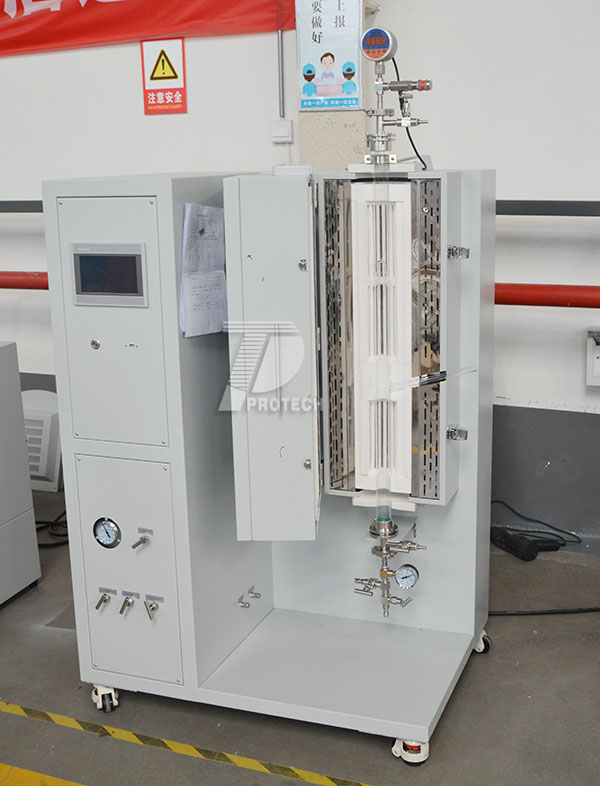


NEWS
The vertical tube CVD coating system is a chemical vapor deposition equipment that combines vertical structure and tube reaction chamber design. It optimizes airflow distribution, temperature uniformity, and space utilization through vertical layout, and is suitable for high-precision thin film deposition needs in fields such as semiconductors, solar cells, display technology, and new material research and development. Let's take a detailed look at the vertical tube CVD coating system below!
1. System architecture: Precise control under vertical layout
The core structure of a vertical tubular CVD system includes a vertical reaction chamber, gas delivery system, temperature control system, vacuum system, and automation control module
Vertical reaction chamber
Adopting a vertical quartz tube or metal cavity design, the substrate is vertically placed on a multi-layer carrier, and the airflow flows from top to bottom to reduce particle settling pollution to the substrate.
The cavity material should have high temperature resistance (such as quartz can withstand high temperatures above 1200 ℃) and chemical inertness to avoid side reactions with reactive gases.
Gas delivery system
Equipped with a multi-channel mass flow controller (MFC), it can accurately adjust the flow ratio of reaction gases (such as SiH ₄, NH ∝, N ₂ O, etc.) to carrier gases (such as N ₂, H ₂) to control the composition of the film.
Some systems use a "shower head" type gas distributor to ensure uniform diffusion of gas onto the substrate surface.
Temperature controller
By using a resistance heating furnace module to achieve temperature gradient control of the cavity, the temperature uniformity can reach within ± 5 ℃, meeting the deposition requirements of different materials (such as 350-400 ℃ for Si-N ₄ and 200-300 ℃ for a-Si).
vacuum system
By combining mechanical pumps and molecular pumps, the vacuum degree of the chamber is achieved to be ≤ 10 ⁻ ³ Pa, reducing the collision frequency of gas molecules and improving the purity of the film.
Automation control module
Adopting PLC or computer control system, real-time monitoring and adjustment of temperature, pressure, gas flow and other parameters, supporting process formula storage and remote operation.
2. Technical advantage: Performance improvement brought by vertical layout
Optimization of film uniformity
The vertical structure allows the airflow to pass vertically through the substrate array, avoiding thickness deviation caused by edge effects in horizontal layout. The film uniformity can reach within ± 3%, suitable for large-area deposition (such as 12 inch silicon wafers or G12 size glass substrates).
Space utilization efficiency improvement
Vertical stacked substrate carriers can simultaneously process dozens of substrates, increasing single batch production capacity by 3-5 times compared to horizontal layouts and reducing unit costs.
Particle pollution control
The direction of airflow is consistent with the direction of gravity, making it easier for particles to be evacuated by the vacuum system, reducing surface defects on the substrate, and improving the yield rate.
Enhanced process flexibility
Supports a wide range of process conditions from atmospheric pressure to high pressure (1-10 ³ Pa) and from low temperature to high temperature (200-1700 ℃), and can deposit SiO ₂, Si ∝ N ₄ a-Si、μc-Si、 Various materials such as carbon nanotubes.

A commonly used vertical tube CVD coating system (click on the image to view product details)
3. Application scenario: Core equipment for multi domain thin film deposition
Semiconductor Manufacturing
Deposition of high dielectric constant (High-k) gate dielectric layers (such as HfO ₂), low dielectric constant (Low-k) interlayer dielectrics (such as SiOCH), and copper interconnect barrier layers (such as TaN) to enhance chip performance and reliability.
solar cell
Deposition of Si ∝ N ₄ anti reflection film (refractive index n ≈ 2.05) on the surface of crystalline silicon cells to increase the light absorption rate; Deposition of a-Si or CIGS absorber layer in thin film cells to achieve flexible and lightweight design.
display technology
Preparation of TFT gate insulation layer (SiO ₂/SiN ₓ stack) and encapsulation layer (Al ₂ O3) in OLED devices, extending device lifespan to over 50000 hours.
New material research and development
Growth of carbon nanotube arrays (deposited with Fe catalyst film and then subjected to CVD catalytic cracking of C ₂ H ₂) or graphene (deposited with carbon source on Cu substrate by CVD) to promote innovation in electronic devices and composite materials.
4. Selection points: Match system parameters according to requirements
Compatibility between cavity size and substrate
Select the cavity diameter and length based on the substrate size (such as 6-inch and 8-inch silicon wafers), ensuring that the substrate spacing is ≥ 10mm to avoid airflow interference.
temperature control accuracy
For temperature sensitive materials (such as organic semiconductors), a system with temperature fluctuations of ≤± 1 ℃ should be selected to avoid thermal damage.
Gas delivery system configuration
According to the process requirements, configure the number of gas channels (such as 4-8 MFC channels) and reserve expansion interfaces to support future new process development.
Automation and safety functions
Priority should be given to systems with safety functions such as emergency shutdown, gas leak detection, and over temperature alarm to reduce operational risks.
Maintenance and Cost
Evaluate the replacement cycle of quartz tubes (usually 500-1000 heats), maintenance frequency and energy consumption of vacuum pumps, and control long-term operating costs.
Overall, the vertical tube CVD coating system, as a commonly used coating system in the heat treatment industry, is highly favored by many university laboratories, industrial and mining enterprise laboratories, etc. Before choosing, you can communicate with relevant technical personnel about the parameters you want, so as to customize a vertical tube CVD coating system that is more suitable for your own experiment!Click to learn more CVD devices! Or click on online customer service to learn more about product information!
Leave A Message